Skiing beginners: 14 tips to learn how to ski
Are you ready to clip into skis for the first time? Nervous about what it entails? Don’t be! We’re here to help – and make things as easy as possible – with Dope Mag’s 14 skiing tips for beginners.

So, #Skitok has taken over your feed, and the FOMO from friends and family dancing outside Folie and floating through pow has peaked. So, you’ve done it: you’ve booked that ski trip. Well, we can guarantee you won’t regret it.
But what should you expect from skiing for the first time? What do you wear? How the heck do you stop? Well, we have all the answers and more in our guide full of skiing tips for beginners. Yep, we lift the lid on what lies ahead so you can have as smooth a time as possible. Welcome to the world of shredding – we’re stoked you’ve joined.
Skiing beginners: 14 tips to learn how to ski
Pssst - If you are still looking for stylish clothing to bring on your next adventure in the mountains, check out our latest collections over at Dope Snow.
Men's ski jackets | Women's ski jackets
Men's ski pants | Women's ski pants
1. Begin with boots
Ah, ski boots. We’d argue these are the most important part of your kit. However, the most common mistake beginners make when hiring ski boots is choosing a pair a size too big because that seems the most comfortable option. Do that, and your feet slide around while your toes scrunch for balance. And, voila – you have the perfect recipe for foot cramps!
Instead, you want a snug pair of ski boots that you can wriggle your toes in – but not be able to lift your heel. Oh, and don’t forget to bend your knees when trying on ski boots. This way, your toes should come away from the front of the boot, and you’ll get a real sense of how everything feels when you're in ‘skier’s stance’. We’ll talk more about that later, though.
If you have any dreaded rubbing, a good ski boot fitter can blow out any areas causing problems. They can also help with choosing the right sized boots for you. And if you get ‘the bug’ and plan to ride every season, nothing beats getting your own ski boots with custom footbeds. Oh, and make sure to leave your ski boots by the heater overnight! You’ll thank yourself in the morning when they’re toasty and easy to get into.
2. Wear the right gear
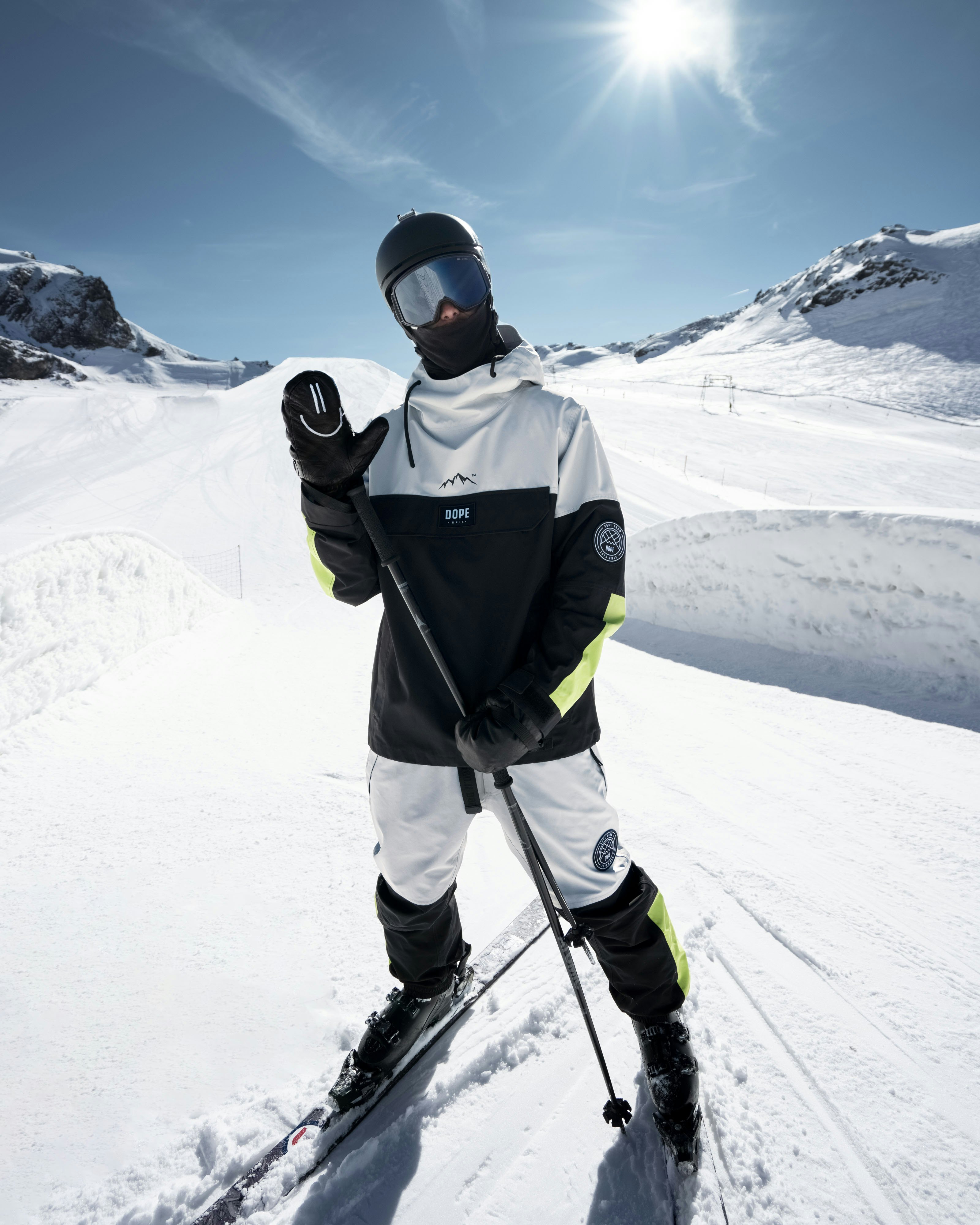
Wearing the right gear is so essential. Layer too light, and you’ll shiver during your lesson. Go too heavy, though, and you’ll be sweating. That’s why it’s key to check the weather forecast and pick the right layers and outerwear.
Plus, make sure you wear a helmet. This will protect you when you fall (sorry for the spoiler alert). Goggles are also super important for protecting your eyes against the elements. And make sure you wear SPF. We know wearing sunscreen in the mountains might seem useless, but snow reflects sunlight. Without it, you might have gnarly sunburn or the dreaded ‘goggle tan’ (where half your face is tanned). Trust us – it’s not a good look when you’re back in the office.
Another beginner error is to wear huge, super thick socks. However, these often bunch and rub, causing boot pain and shin splints. Instead, wear specific ski socks for a better boot fit. Proper ski socks also allow your feet to breathe, so they won’t get sweaty and stink out the chalet at the end of the day. Bonus.
3. Rent skis (don’t buy them)
We won’t sugarcoat it: ski trips can be a splurge. But you can save by renting your skis rather than buying them – especially as a beginner! You see, beginner skis are slightly different lengths and shapes to intermediate and advanced skis. So, as you progress, you might want to try rocker skis, carving skis, fat skis for pow, etc., and not be stuck with your outdated first-ever pair.
Plus, if you book ski lessons (Tip Number 5!), most include equipment hire in the lesson cost. So, it’s an awesome way to save your dollars once you’re out there. And, our favorite thing about renting? You can easily swap your skis if you want to try another pair every few days.
Ski technicians working in hire shops can also recommend the best skis for your height, weight, and ability. Don’t forget to bring your ski boots with you, too. That’s because ski techs can make sure your ski boots fit into your bindings and you have the correct DIN settings, which determine how easily your foot unclips from your bindings when you fall. That sounds sketchy, but trust us – it’s actually a good thing!
4. Learn how to get in and out of your skis
Now it’s time to clip in and get going! For this, you’ll need to clip your boots into your bindings. To do that, touch your toes to the front of the bindings and push down with your heel. Hopefully, you’ll see the back of your binding click up. This means you’re locked, loaded, and ready to go! Oh and always start with your downhill ski first.
Sometimes, clipping into your bindings can be a hassle. This tends to be the case if you have a lot of snow packed into your boots – often from walking. There’s an easy solution, though. Just stomp on the front of your bindings to kick out the snow. Then, try clipping back in.
If you’re learning with poles (read our FAQs for more about this), lean on them for balance when clipping into your bindings. Ski poles are also great for helping you get out of your skis. For this, you can use your poles to press down on the back of your bindings. No poles? Use your other ski to step on the back. After you’ve pressed down, the bindings will release. Then, it’s time for après, baby!
5. Book a lesson
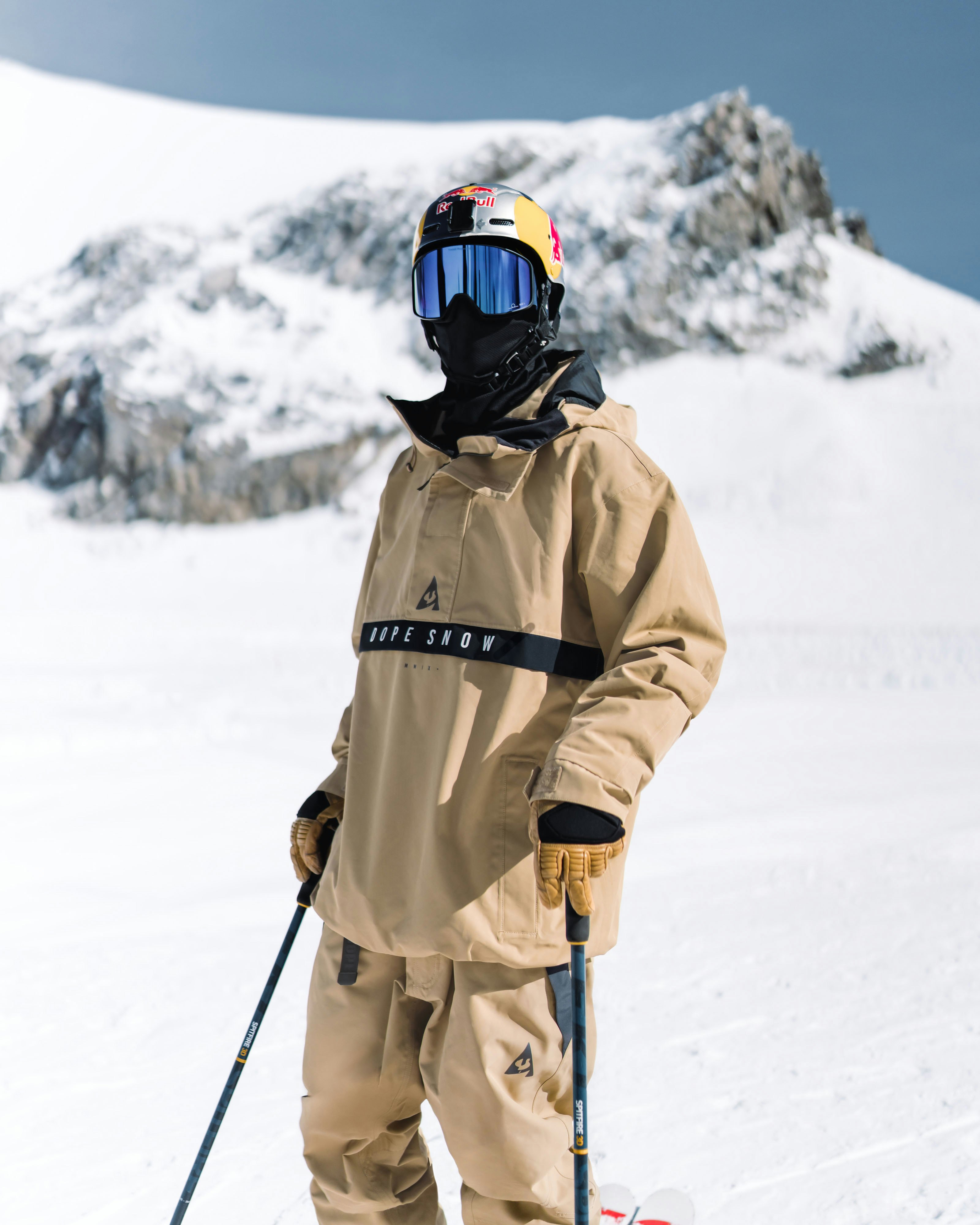
Having a ski lesson is possibly the oldest advice out there. But there’s a reason why. You see, ski lessons come with ski instructors who can teach you proper form and techniques – and prevent any bad habits developing. In fact, booking a ski lesson can help you progress way quicker than having your partner, friend, or family member teach you.
And don’t worry – different ski lessons exist for varying levels. For example, there are ski lessons for those who haven’t touched snow before, those who need a refresher, and those who want to sharpen their techniques. Whichever ski lesson you choose, your ski instructor will work with you on your goals for the days and week (or weeks) ahead.
Whether you have a one-on-one or group ski lesson is totally up to you. Both have their advantages. For example, a one-on-one ski lesson means the instructor can give you their full attention. However, group ski lessons are a great way to make friends and meet new people – especially if you’re all starting from the same level and learning together throughout the week.
6. Bend your knees
Ski instructors worldwide remind their students to ‘bend your knees’. However, it’s for a very good reason. You see, bending the knees puts you in the perfect ‘skiing stance’.
The perfect stance is where your legs are stacked under your torso, your weight is forward (centered over your feet), your shins are touching the front of your boots, your shoulders are pointing downhill, and you’re in control of the skis. Yes, we know you might think the skis have all the power, but bending the knees and leaning forward is the secret to gaining control – and showing those skis who’s boss. Plus, you’ll keep your balance and avoid ‘back seat skiing’ (when your bum is sticking out!).
Don’t look down, either! Yes, we know it’s tempting to stare at the skis attached to your feet, but this will just lead to your skis crossing – and you falling! So, bend your knees and fix your gaze at least 10 feet ahead. You can see the upcoming terrain while acknowledging other riders in your peripheral vision. Plus, looking ahead will mean your body instinctively moves in that direction. Easy.
7. Prepare to glide, side-step … and fall
Once you’ve nailed your stance, you’ll get used to skis by gliding on flat terrain. Gliding is where you keep your skis parallel, push off with your poles, lean forward, and move. From there, you’ll progress to a gentle slope.
But how do you get back up the slope? Side-stepping! This is where you take small steps up the hill while facing across the slope, i.e., your skis are perpendicular to the fall-line (scary name, we know, but it just means straight down the mountain!). Side-stepping is a skill you’ll use as you progress – even if you get into ski touring one day!
And amongst all of this is one inevitability: falling. Multiple times. Yep, it happens to the best of us and isn’t something to be scared of. In fact, falling is a 100% natural part of learning. And remember that snow is always way softer than you think. However much you fall, though, don’t give up, get back up, and keep on going. It’ll all click into place eventually. We promise.
8. Perfect your Pizza and progress to Parallel
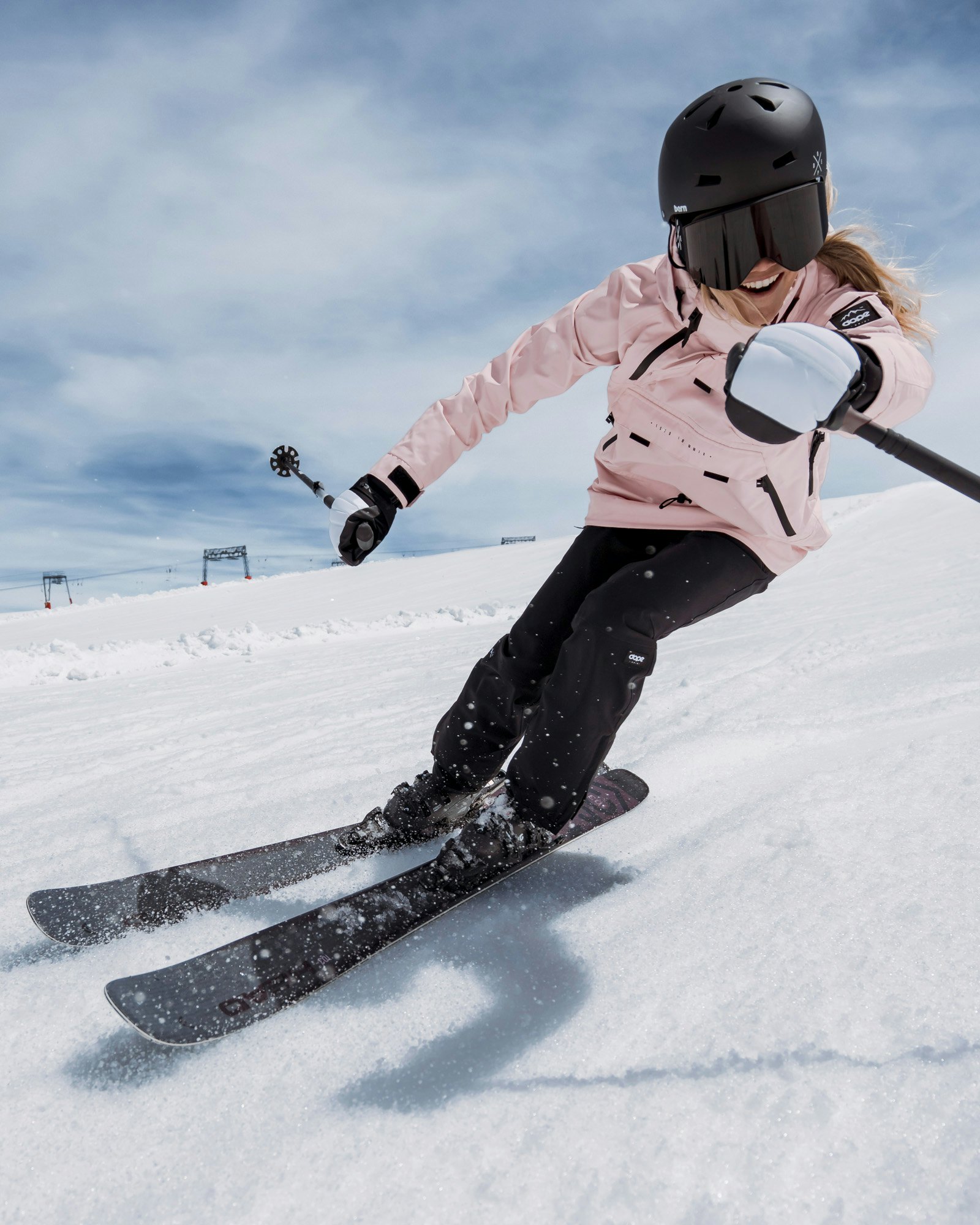
If you ever hear someone shouting “Pizza! Pizza!” on the beginner slopes, they’re either reminding someone to snow plough – or they’re just really excited about lunch. Snowplough is when you point your skis in a triangle position (like a pizza slice, getit?), with the tips pointing inwards towards each other.
Snow plough position is going to be your go-to when learning. You’ll use it to learn to turn, control your speed, and come to a complete stop. And it becomes an invaluable skill as you progress. Heck, advanced riders still use it when going down steep, icy tracks. As you learn, though, don’t forget to turn up the hill. This will greatly help control your speed so you can focus on the next turn.
Once you’ve bossed your Pizza, it’s time to progress to French Fries. This is known as parallel turns, when you keep your skis straight to one another (like two french fries, you see) as you enter and exit the turn. The move from Pizza to French Fries means your skiing will ‘flow’ better, and you’ll glide instead of stop-starting.
9. Conquer getting on and off ski lifts
Ski lifts can seem daunting – especially as so many different types exist. For example, you’ll find magic carpets, rope tows, T-bar/button lifts, chair lifts, gondolas, and more. But all of them are much easier to get on and off than you might think. Plus, conquering a few will make getting around the mountain a breeze.
On the beginners’ slopes, you’ll likely only ever have a magic carpet, rope tow, or small drag lift. For the magic carpet, step on and off it with your skis attached (easy!). For the rope tow, get yourself parallel to it and grab the moving rope (with your gloves on!). It’ll pull you up the slope, and then you let go when you reach the top.
Drag lifts (also known as Pommas or button lifts) are a touch trickier but still totally achievable. Just grab a T-bar/button, pull it down, and place the seat behind or between your legs. As you progress, you’ll come face-to-face with chairlifts. There are also gondolas, which are large carriages that carry multiple skiers at once. Whichever lift you’re starting with, let the liftie know you’re learning – they’ll often slow the lifts right down so you can get on and off easier. And it all becomes second nature before you know it.
10. Keep to the bunny slopes and groomers – for now
We know your feed’s probably flooded with #goals of skiers floating through pow or stomping the park. And we don’t blame you for wanting to get to that point as quickly as possible. However, as a beginner skier, stay on the bunny slopes and groomers until you’re ready for anything else.
Sure, everyone progresses in their own time. However, it generally takes skiers around 10 weeks to feel confident on all types of slopes, including steep blacks. And riding pow and venturing off-piste is a whole other ball game. In fact, if you set your ambitions too high, you might shatter your confidence – and your ACL! So, stay within your limits, and take pride in your day-to-day progression rather than trying to match anything you see online.
And this is where picking the right ski resort comes into play. Tons of resorts are awesome for beginners, with mellow slopes, beginner-only areas, ski schools, family programs, and more. So, choose a ski resort that bigs up beginners for your first time skiing. That way, you won’t feel tempted to hit anything too gnarly too soon.
11. Familiarize yourself with slope etiquette
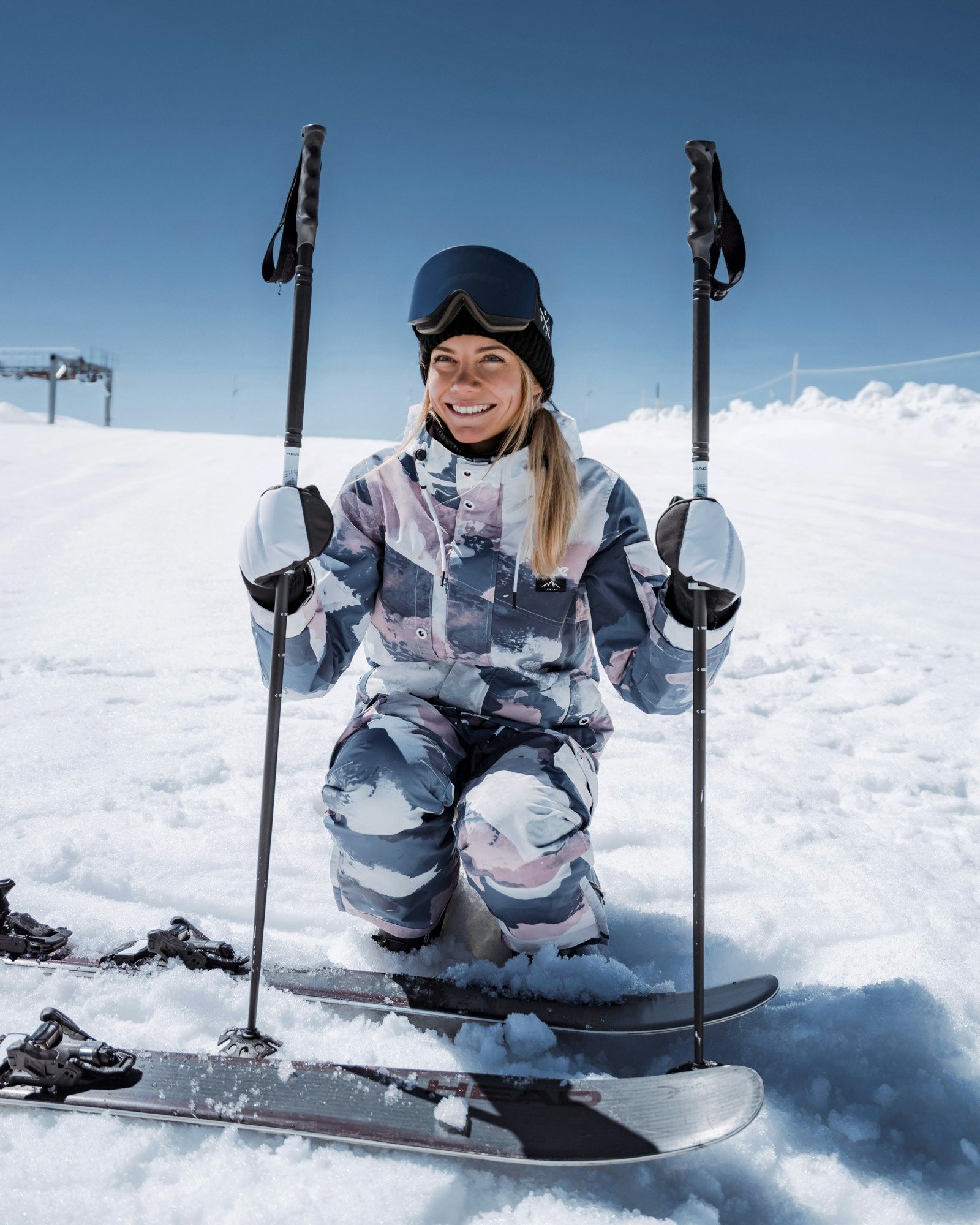
The mountains can seem like the Wild West if you’re not used to them. Luckily, you can brush up on your slope knowledge and etiquette to have a safe time on the slopes. This includes – but isn’t limited to – knowing your slope colors and symbols. Because no beginner wants to take a wrong turn and end up on a mogul-filled black diamond! This also goes hand in hand with knowing your limits. For example, don’t deliberately attempt a black diamond when you’re not ready!
However, even when you’re on a slope you’re comfortable with, take a look around you before setting off so you don’t crash into other riders. This includes looking up the hill before skiing. Typically, the rider above you is responsible for the skiers and snowboarders below. However, they might not see you, so it’s always best to check around before riding.
And never stop in the middle of a slope, either. If you need a breather, stop at the side instead. This makes sure you’re out of the way of other riders – especially those who are hacking down at speed and might not see you until it’s too late. And, if you do see someone stack it, stop to help. You’d be grateful if someone stopped to check if you were okay, right?
12. Build your leg strength
We know this is a massive spoiler alert, but man, does skiing take it out on your legs! It’s no surprise when you think about it, as learning to ski means putting your legs in a squat position for most of the day! Yikes!
So, anything you can do pre-trip to build leg strength will help immensely. This includes squats, lunges, weight lifting, getting on the leg-press and leg-extension machines … basically, anything to supercharge your quads and calves. You’ll have more stamina to learn from first lifts to last chair. Well, with a well-earned lunch break in between!
Stretching is also massively important before and after skiing. Simple stretches to your hamstrings, glutes, and calves will keep you loose and limber – and avoid any dreaded cramps. Ah, and that reminds us: hydration is super key, too. And no, we don’t mean just beer at après-ski …
13. Practice, practice, practice
We all know the saying ‘practice makes perfect’ – but it’s particularly true with skiing. Simply put: nothing beats putting in the time on the hill to perfect n’ progress. And that means getting out on the mountain, whatever the weather. Yes, even in a whiteout. Rubbish conditions help you appreciate those bluebird days even more – and make you a better skier.
And our top piece of advice? Ride with skiers better than you. However, make sure your riding amigos are understanding and know your limits. There’s nothing worse than riding with the pro friend who sticks you on a black diamond on your second day!
Some of your buds might follow the ‘no friends on a powder day’ motto. However, if that’s the case, you can always ski solo on the beginner slopes to practice your turns. In fact, riding solo can be super beneficial as you’ll focus on form rather than fretting about keeping up with the crew.
14. Head to après-ski – you deserve it!
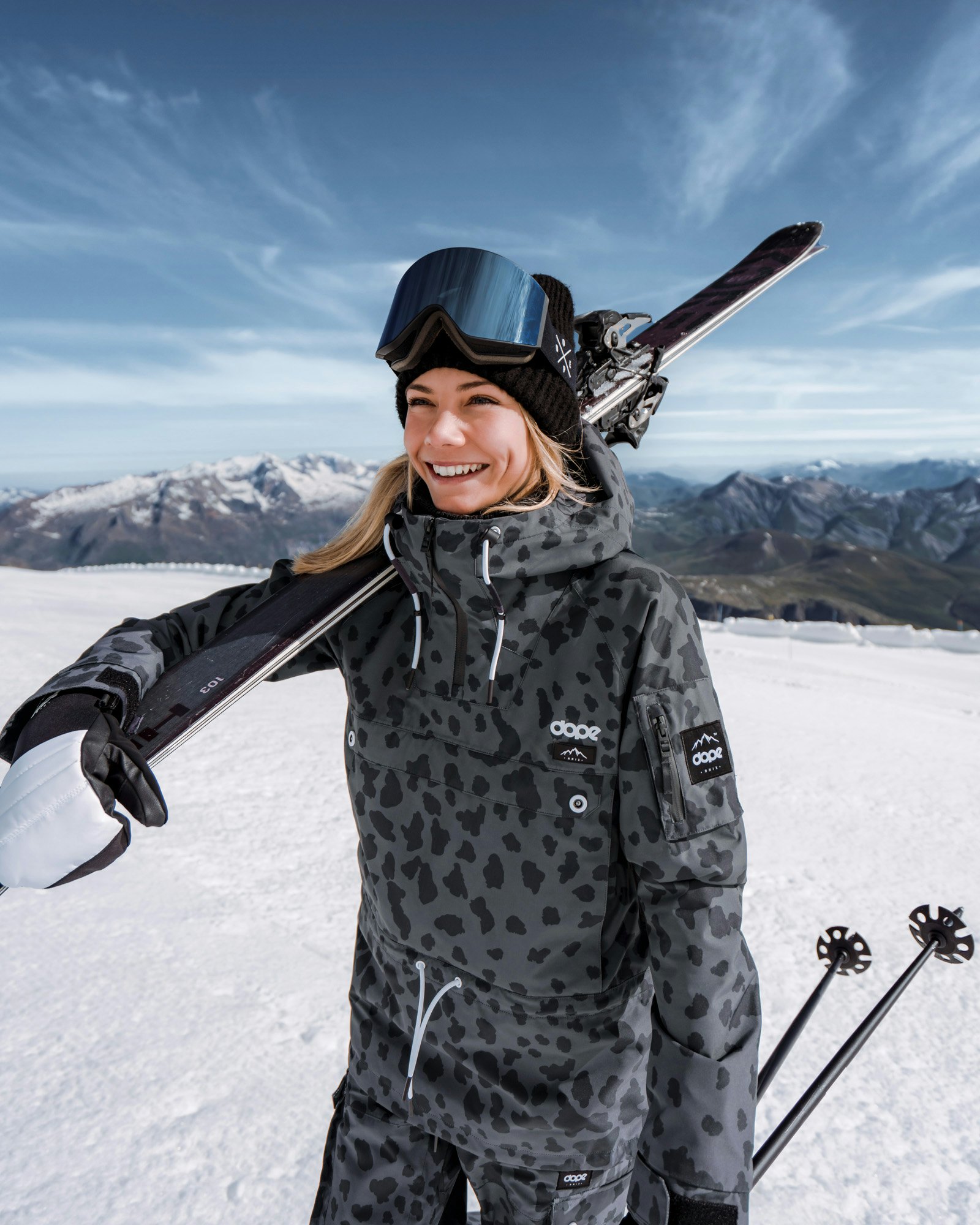
Après-ski is the pièce de résistance of a day on the slopes. It’s when riders gather at the bars (without changing first), drink, dance, and swap stories of their day on the slopes. Yes, we might get misty-eyed over it, but après once, and you’ll pine for it forever, too.
And not to sound too much like your mum, but make sure you down a pint of water before a pint of booze. That’s because skiing is a workout, and you want to make sure you’re rehydrated before hyping up for après. Just don’t forget that first lifts – and ski lessons – are usually 9 am the next morning!
Wondering what happens to your gear while you’re partying? Clip your helmet under a table or onto the chair and stash your goggles in there to prevent any scratches (wrap them in a goggle sleeve for extra protection). Worried about helmet hair? Wear a beanie! You can stash one in your pocket for such an occasion when riding. And your ski boots? Embrace them, baby! Yep, dancing in ski boots is a skill you’ll quickly master when learning to après-ski.
FAQs
Do you need a lift ticket to learn to ski?
It totally depends on where you go! Some ski resorts offer free beginner areas and bunny slopes, while others require a lift ticket. Those requiring a lift ticket typically provide half-day, full-day, and multi-day lift tickets – and sometimes beginner packages that include equipment hire and ski lessons.
If you want to know what’s available before you go, head to your chosen ski resort’s website. Most allow you to book your lift ticket online. If you’d rather wait until you’re in-resort, head to the local lift ticket office to buy your pass. Once you have it, pop it in your ski jacket (there’s usually a dedicated pocket on your left forearm), and you’re ready to ride.
Do you need ski poles when learning to ski?
So, this is quite a controversial question as some people are firm believers in learning without ski poles while others state you’ll need them later, so why not start right away? It also comes down to your ski instructor and which technique they prefer.
Generally, though (and this is being super general), most beginners start without poles. That’s because your first focus is your legs, balancing, stopping, and mastering that basic turn technique – and poles can be too much of a distraction at this point. Once you can stop, turn and control your speed, it’s time to introduce poles. They’ll help your balance, timing, and rhythm as you progress to more advanced terrain.
How do you carry skis?
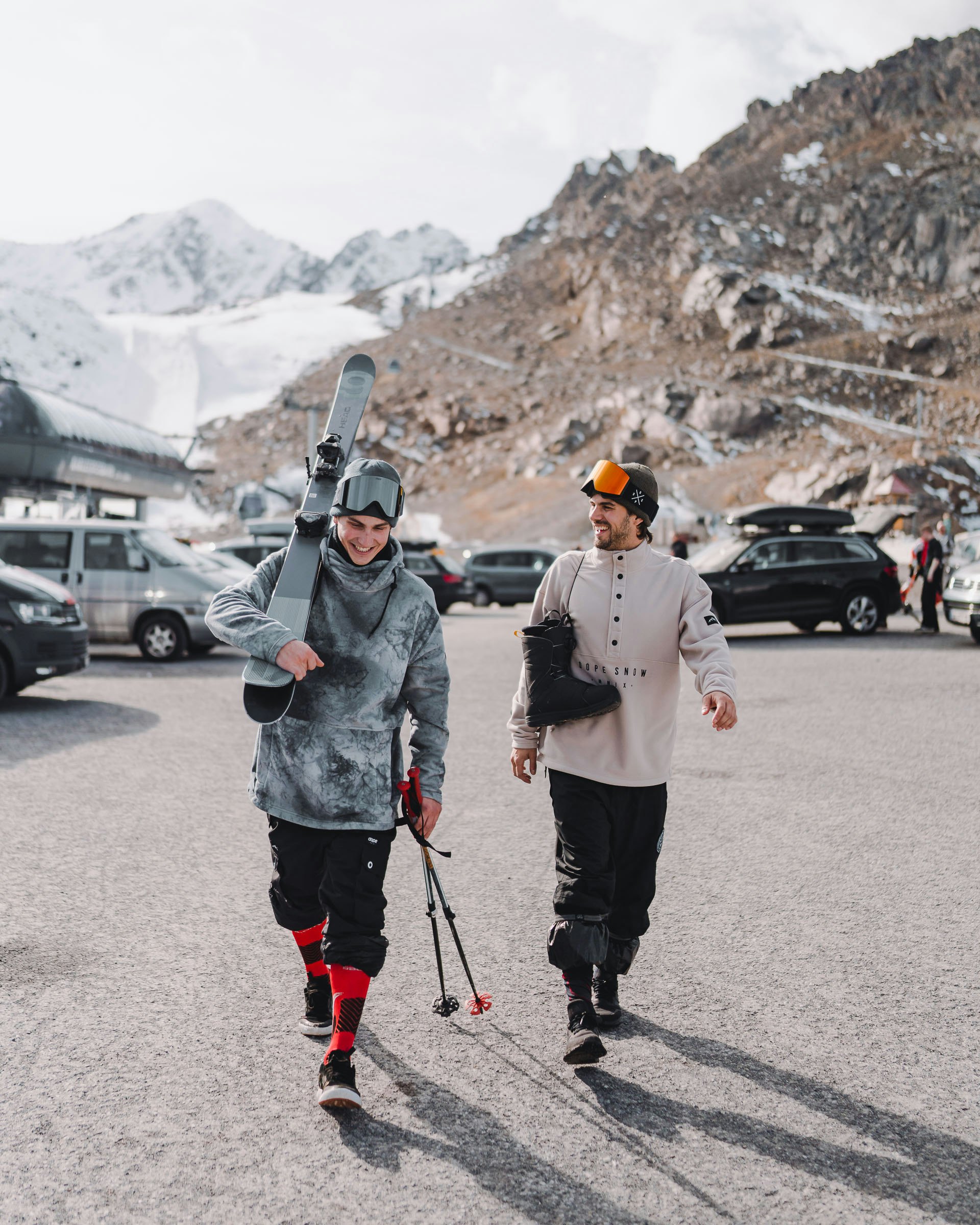
Carrying your skis might seem like a mission, but it’s actually pretty easy. First, put them together – base to base – with the brakes overlapping. Then, place the skis over either shoulder with the brake of the higher ski inside the lower ski’s brake. This means they can’t slip apart.
Place the front of the binding behind your shoulder with the tips pointing down. Hold the skis in place with the arm they’re resting on and carry your ski poles in your other hand. If that method’s a bit uncomfortable – or you want to switch things up – lock your skis with the brakes. Then, keep them vertical, lift, and carry them that way. Boom!
Can you walk in ski boots?
Absolutely! Okay, you might have a cowboy swagger, but you can walk around in your ski boots, no problem – and even conquer stairs! Just walk normally and don’t overthink it. It’s heel, toe, heel, toe.
Our top tip is to have your boots on the loosest setting when walking about – or dancing at après-ski! Still keep your buckles flipped down, though, as there’s nothing worse than your buckles catching one another and sending you flying or tripping over the velcro power straps – especially when carrying a tray of beer! Believe us: we’ve seen it happen.
Wrapping up
Wowsers – who knew skiing involved so much stuff, right? Yep, we totally get it might seem overwhelming right now. However, skiing opens so many doors, and very few things compare to the rush of charging down a mountain surrounded by stunning scenery and awesome people.
Speaking of awesome people, why not join other awesome riders over on the Dope Snow Community on Facebook? Just request to join if you haven’t already, and let us know how your skiing journey goes by posting updates. We can’t wait to see how it transforms your life!
Related reading:
